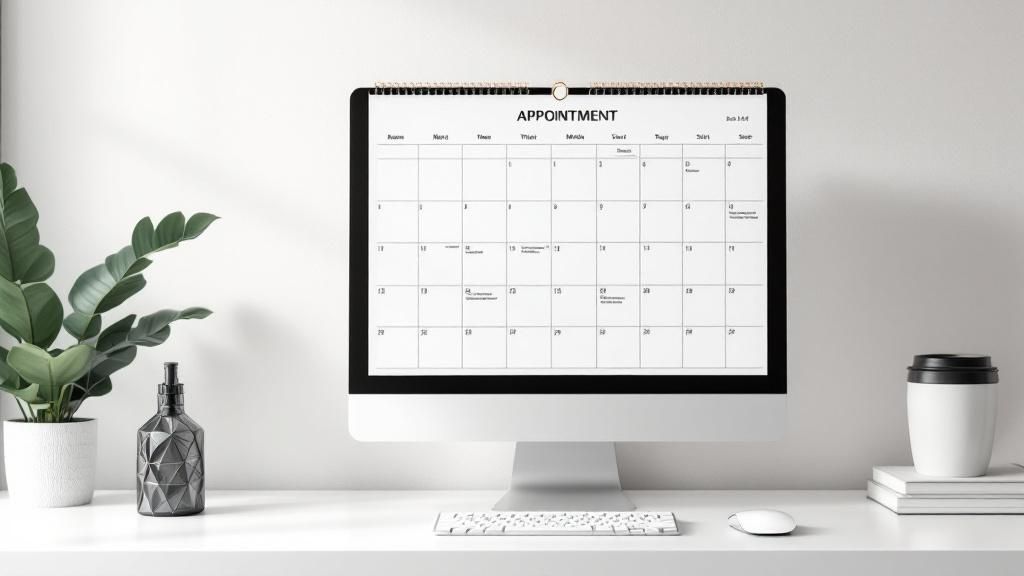Understanding What Virtual Medical Receptionists Really Do
Let's be honest, the term "virtual medical receptionist" can sound a bit futuristic or even impersonal. But really, it's just about adding a smart, specialized assistant to your team without needing to find space for another desk in your office. These systems, often powered by advanced AI, are much more than a simple answering service. They're built to handle the routine, time-consuming admin work that can easily overwhelm your front-office staff.
This isn't a niche concept anymore. The global market for virtual receptionist services is projected to reach USD 25 billion by 2025. You can find more details on this growth and what it means for businesses on LLCBuddy.
So, what does one of these digital assistants actually do in a busy clinic? Let's take a look.

The main job of a virtual medical receptionist is to be that first point of contact, managing patient calls and requests intelligently. This is a game-changer because it frees your in-house team from being glued to the phone. Instead, they can give their full attention to the patients who are physically in the clinic, which is a huge factor in boosting the overall patient experience.
Essential Features That Transform Your Practice Operations
When you think about a virtual medical receptionist, the first thing that probably comes to mind is appointment scheduling. While that's a core function, the real magic happens with the more advanced features that solve your biggest administrative headaches. Imagine intelligent call routing that sends a patient with a billing question straight to the right person, without ever tying up your front desk. Or think about automated insurance verification, a feature that can save your staff countless hours by confirming a patient's coverage before they even walk in the door.
These aren't just small perks; they represent major upgrades to how your practice runs. For instance, some platforms like Simbie AI use sophisticated natural language processing to handle complex patient requests, like prescription refills, with remarkable accuracy. This kind of high-level capability is what separates a decent system from an indispensable one. Building solid healthcare communication strategies is crucial, and these tools offer a new and effective way to put them into practice.

The dashboard pictured above gives you a peek into how a platform like Simbie AI provides clear, useful data. This kind of visibility into call volumes and resolutions lets managers pinpoint exactly where the virtual receptionist is boosting efficiency.
Must-Have vs. Nice-to-Have Features
Not all practices need every single feature. To help you figure out what's essential for you, we've put together a guide to prioritize features based on your practice's size and needs.
| Feature | Small Practice Priority | Large Practice Priority | Implementation Difficulty |
|---|---|---|---|
| Appointment Scheduling | Must-Have | Must-Have | Low |
| Call Routing | Must-Have | Must-Have | Low-Medium |
| Automated Insurance Verification | Nice-to-Have | Must-Have | Medium |
| Prescription Refill Requests | Nice-to-Have | Must-Have | Medium |
| EHR/EMR Integration | Must-Have | Must-Have | High |
| Customizable Call Scripts | Must-Have | Must-Have | Low |
| Analytics & Reporting | Nice-to-Have | Must-Have | Low |
| Patient Intake Forms | Nice-to-Have | Must-Have | Medium |
Table: Must-Have vs Nice-to-Have Virtual Receptionist Features
Strategic feature prioritization guide for different practice sizes and budgets
As you can see, features like automated insurance verification and detailed analytics become more critical as your practice grows and patient volume increases. However, one feature is non-negotiable for almost everyone: seamless integration with your existing EHR/EMR system. This connection is vital because it allows the virtual receptionist to do more than just answer calls—it can directly update patient records, making your entire workflow smoother and more connected.
Choosing Your Perfect Virtual Medical Receptionist Match
Picking the right virtual medical receptionist feels less like choosing software and more like finding a new, essential partner for your practice. With so many options out there, it's easy to get lost in slick marketing. The trick is to look past the promises and see what a platform can actually do for you. Start by asking specific, direct questions. Instead of just asking if a service integrates with EHRs, ask for a live demo showing exactly how it connects with your specific system.

As you can see, modern healthcare is a web of interconnected technologies, from patient records to diagnostic tools. Any new addition, especially a virtual medical receptionist, needs to fit perfectly into your existing setup to be truly helpful.
Key Evaluation Questions
To get straight to the point and find the best fit, here are a few things I always recommend asking about:
- HIPAA Compliance and Security: This is non-negotiable. Ask them to explain how they encrypt patient data, both when it's stored (at rest) and when it's being sent (in transit). Don't be shy about requesting their security documentation.
- Scalability: What happens if you have a sudden spike in calls, maybe during flu season? Can the service keep up? It's also smart to ask what the pricing looks like if your practice grows and you need more capacity down the road.
- Support and Training: How will they help your team get comfortable with the new system? Find out what their onboarding process includes and if you'll have to pay extra for technical support later on.
Assessing the Financials
There's no doubt that these services are becoming more popular. The market for healthcare virtual assistants was valued at USD 1.41 billion in 2025 and is projected to hit an incredible USD 19.2 billion by 2035. This rapid growth shows just how important it is to pick a provider that’s built to last. You can find more details about this market growth on Future Market Insights.
A great way to test the waters without a big commitment is to ask for a pilot program. This lets you see the service in action, measure the real-world return on investment, and spot any hidden costs before you're locked into a long-term contract.
Crafting Your Implementation Strategy for Seamless Adoption
Bringing a virtual medical receptionist into your practice isn't just a switch you flip overnight. A thoughtful strategy is key to avoiding disruption and ensuring your team and patients get on board with the change. Success starts with preparing your staff, not just with software training, but by talking openly about their concerns. Show them how this new tool will take administrative busywork off their plates, not replace them.
A phased rollout is often the smoothest path forward. For example, you could start by having the virtual assistant handle only new patient appointment requests for a week or two. This lets you test the system in a controlled, low-risk way before giving it more responsibilities.
Training and Transition
Good training is all about workflow changes. Instead of just teaching your team how to click buttons in the software, teach them how to work with it. Role-playing different situations is a fantastic way to do this:
- What's the new process when a patient calls with a tricky insurance question?
- How does the virtual receptionist hand off an urgent call to the on-call nurse?
- Where does staff now find the information captured during an automated patient intake?
This hands-on approach builds confidence and smooths out the transition, making sure your quality of service never dips.

The image above gives you a peek into the complex data flows in modern healthcare, which a virtual medical receptionist has to handle. A successful rollout depends on making sure this new technology integrates cleanly with your existing systems for clinical records and patient information. Luckily, this integration is easier than ever, thanks to how comfortable patients are with technology. In fact, a past study found 93% of doctors believed mobile apps could improve care, a trend that has only grown. You can find more data about the rise of mobile health platforms at Meticulous Research.
Keeping Patients Happy While Embracing Automation
A common worry for practices is that patients will feel disconnected or frustrated when interacting with a virtual medical receptionist. However, experience often shows this fear is unfounded. The secret isn't just about automating for the sake of it, but about intelligent implementation. True success comes from creating a system where technology handles routine tasks efficiently, while always providing a clear and immediate path to a human for more complex or sensitive issues.
This diagram highlights how patient satisfaction is influenced by multiple factors, with communication and accessibility being key. A well-designed virtual system directly improves these areas by getting rid of hold times and giving instant answers to common questions.
Blending Empathy with Efficiency
The aim isn't to replace your team's personal touch but to free them up to provide it when it matters most. Think of it this way: a virtual assistant is perfect for scheduling a routine check-up or confirming clinic hours. But for a distressed patient who needs to discuss urgent symptoms, the system should be smart enough to recognize the need for empathy and seamlessly transfer the call to a nurse or another staff member.
To strike the right balance between automation and personal care, it's helpful to map out which patient interactions are best suited for a virtual assistant and which absolutely require a human touch.
Virtual vs Human Touch Points in Patient Care
Strategic guidance for optimizing patient interactions across different scenarios
| Patient Scenario | Virtual Assistant Capability | Human Backup Needed | Patient Satisfaction Impact |
|---|---|---|---|
| New Patient Registration | Gathers basic demographic and insurance information via a secure digital form. | Staff member available for questions about insurance coverage or practice policies. | High: Patients appreciate the convenience of pre-registering on their own time. |
| Routine Appointment Booking | Offers available slots based on doctor, time, and appointment type. Sends confirmations and reminders. | No, unless the patient has a complex scheduling need (e.g., coordinating multiple specialists). | High: Instant booking without waiting on hold is a major plus for busy patients. |
| Discussing Test Results | Can confirm that results are ready and provide instructions on how to access them via a patient portal. | Absolutely. A licensed professional must deliver and discuss the actual results. | Critical: Automating result delivery is a major risk; personal discussion is essential for trust and clarity. |
| Prescription Refill Request | Processes standard refill requests and sends them to the pharmacy. | Yes, for any questions about medication side effects or dosage changes. | Moderate to High: Efficient for routine refills, but access to a human for questions is a must. |
| Urgent Symptom Complaint | Can use keyword recognition (e.g., "chest pain," "difficulty breathing") to immediately escalate the call. | Immediate and Essential. The call must be routed directly to clinical staff or emergency services. | Critical: A failure here can have serious health consequences and destroy patient trust. |
| Billing Inquiry | Can provide account balance, due dates, and links to online payment portals. | Yes, for complex disputes, setting up payment plans, or explaining detailed charges. | Moderate: Self-service is helpful, but financial conversations often require a human's nuance and empathy. |
This table shows that the best approach is a partnership. The virtual assistant handles the predictable, freeing up your team to manage the situations that require their expertise and compassion.
Platforms like Simbie AI are built with this balance in mind, ensuring the warmth and professionalism patients expect are always present. It's crucial to regularly review patient feedback and tweak the system's responses based on real-world interactions. For more ideas, you can check out our guide on how to improve patient satisfaction scores. This strategy ensures technology serves your patients, not the other way around.
Tracking Success and Proving Your Investment Pays Off
When you bring a new system into your practice, you need to know it’s actually making a difference. With a virtual medical receptionist, proving its worth goes way beyond simply saving money on a salary. To see the full picture, you have to look at the Key Performance Indicators (KPIs) that really show how your practice is running and how patients feel about their experience. These metrics tell the complete story of your return on investment (ROI).
Key Metrics to Monitor
Instead of getting bogged down by a ton of data, it’s best to concentrate on the numbers that truly matter for a healthcare practice.
- Call Abandonment Rate: What percentage of people hang up before they even get to talk to someone? If you see this number drop, it’s a direct win for patient access. It’s a big deal, considering some studies show 74% of patients hang up after being put on hold.
- Staff Productivity: Is your on-site team getting bogged down by the phone? A key benefit is freeing them up to focus on higher-value tasks, like helping patients at check-in or sorting out complex billing questions. This is a direct boost to your team's efficiency.
- Appointment Booking Efficiency: How fast are new appointments getting on the calendar? A virtual assistant can schedule appointments instantly, 24/7, which is a fantastic way to fill your schedule and increase revenue.
Understanding Your ROI
You might have seen the standard formula for calculating Return on Investment, like in this screenshot.
While the math is straightforward, the "Net ROI" in a medical setting includes so much more than just dollars and cents. Think about gains like higher patient satisfaction scores and a happier, less burned-out staff. These less tangible improvements are just as important as the financial ones. By tracking these metrics, you can clearly show the full value a virtual medical receptionist brings to your practice.
Ready to see a clear return on your investment and improve your practice operations? Explore how Simbie AI can transform your front desk today.

